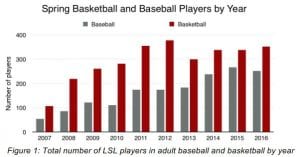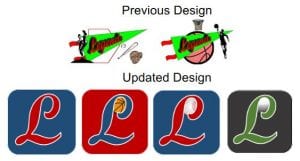Developing a Marketing Plan for Legends Sports Leagues
Authors
Pavel Eroshenko, Tyler K. Jaskoviak, Ajay Brian King, Nicholas L. Kulick
Sponsor
Legends Sports Leagues
Advisors
James Hanlan, Stephen McCauley
Term
October – December 2016
Project Outcomes
Abstract
This project created an evidence-based marketing plan for Legends Sports Leagues in Northern Virginia. We evaluated the current state and growth opportunities available to Legends by conducting surveys, interviews, and game observations to create recommendations concerning the league’s opportunities for growing membership and attracting corporate sponsors. Together with recommendations, we provided a set of deliverables: survey results, promotional videos, a redesigned website, and a marketing brochure.
Executive Summary
Introduction
Legends Sports Leagues (LSL) is a recreational sports league started by Ron J. Cortese that emphasizes camaraderie and sportsmanship for its adult and youth participants in the Washington, D.C., metropolitan area. Today, over 2,000 people are taking advantage of the opportunities that LSL offers. Due to the league’s current success, LSL is looking to continue to grow its membership. In addition, LSL wants to attract more corporate sponsors which would allow them to support the increase in members. A broader marketing plan would enable further growth of the league.
The main goal of the project was to create an evidence based marketing plan. We have created five main objectives to work towards the goal of increasing members and corporate sponsors. Our team’s objectives were to evaluate and assess all the leagues LSL offers, evaluate the current sponsors, and then design an evidence based marketing plan.
History of Legends Sports Leagues
For more than 20 seasons, Legends Sports League has been one of the leading recreational sports organizations in Fairfax County, located in the DC metropolitan area. This league was started by Ronald J. Cortese who developed an affinity for creating a league when he formed a racquetball league in his company. LSL focuses on pride and camaraderie across its teams and skill levels (Cortese, 2016).
Legends started in 2006 with three adult (19 or older) baseball teams. Over the next several years, LSL grew to 20 baseball teams and began an adult basketball league allowing year-round play, even for the winter season. Starting from six adult teams, the basketball league has expanded to over 40 in recent years (the growth of these adult leagues is illustrated in Figure 1).
Cortese also decided to start a youth basketball program that consists of multiple skill levels with children ranging from third grade to high school levels. In August 2016, LSL expanded to golf starting with 24 participants in 12 teams. Legends would like to continue to grow its membership and attract more corporate sponsors
Project Approach
The goal of this project was to increase the number of people who participate in LSL events by creating a marketing plan that will help Legends attract new players and sponsors. In order to accomplish this, the project was broken into three phases: data collection, data analysis, and marketing plan and deliverables.
Phase One: Data Collection
In order to collect the data necessary for a marketing plan, we conducted interviews with key officials, distributed surveys to players in each league, and attended games. Some of the collected information included the satisfaction of participants, league’s advantages and drawbacks, marketing presence, and improvement potential.
We interviewed 11 key stakeholders that either worked or played for Legends. Then, we distributed the survey to determine players’ opinions about Legends. This survey was emailed to all players who have participated in the last five years. For the youth players, the survey was sent to their parent or guardian. In order to understand the game experience and organization, we attended eight different Legends games and collected observations about each.
Phase Two: Data Analysis
Since the data was collected in three different forms, it was analyzed accordingly. We conducted interview, survey, and game observation analysis. The interviews from key stakeholders were analyzed by looking for common themes between interviews. The topics involved improvements and obstacles the league experiences, marketing techniques, and league’s advantages. The survey data was analyzed by using Qualtrics. Graphs and tables were created to represent the range of answers players gave. While analyzing the survey data, reoccurring and prominent common answers (more than 50% of participants) were taken as important aspects to address in the recommendations. Game observations were analyzed by reviewing notes taken at each game. The analysis involved looking for common practices or instances that Legends performed.
Phase Three: Designing a Marketing Plan
The marketing plan was created using the analyzed data. The recommendations constructed from the analyzed data were compiled into a separate document. The project also included a few deliverables including two promotional videos, website changes, a new logo, marketing brochure, and a full report of survey data.
Research Findings
The first common theme found was Legends’ expansion through word of mouth. Many interviewees explained the importance of word of mouth in starting and growing the league. Most survey participants also indicated that they had learned about Legends through word of mouth showing the importance of this strategy when growing the league and therefore were considered while designing the marketing plan.
Another common theme discovered was the importance of friendly competition and camaraderie found in the league. When asked about what players enjoy most about the league, common responses mentioned how the league has a friendly environment but still is competitive. Nelson Taveras, the former Prince William County (PWC) basketball commissioner, also talked about how people enjoy the competition and that teams continue to sign up in future seasons with the same teams and people. This common theme shows a message that can be highlighted in a marketing message to possible new members.
The last common theme found was the importance of promoting Legends brand awareness. Nelson Taveras, the former Prince William County Baseball Commissioner, explained how he initially advertised Legends to the people of Prince William County by distributing flyers and pamphlets. Taveras said this technique was effective in getting people to join. In an interview with volunteers in the youth basketball league, the interviewees expressed their belief that Legends may not have reached the full potential of players. When it comes to the basketball league, the volunteers stated that more people would likely join if they knew about it.
The Marketing Plan for Legends Sports Leagues
There are four high priority recommendations that were determined to be advantageous for the league to implement. We advise that high priority recommendations be completed as soon as possible.
The first recommendation involves increasing the marketing presence at and around LSL games and the venues. Seven out of the eight games attended did not have any such presence. A marketing presence will also allow spectators and other passers-by to know that a Legends game is going occurring. Signage and banners that can be put up in gyms, dugouts, courses, or possibly even on school property during game hours would be effective.
The second high priority recommendation involves increasing marketing presence as well but with more of a focus on the local level. In order to increase LSL brand awareness in the Fairfax area, the distribution of flyers and pamphlets detailing the league and how to join are important. Keeping social media up to date would increase overall interest in the league and may even increase its value in the eyes of the members. Posts should be made at least every week on all platforms to maintain interest. Promotional videos regarding the baseball and Little Legends leagues are good material to post on social media.
Another high priority recommendation is the implementation of a referral program. When a current Legends member refers a new person to the league both will receive a 10% discount for that season. This will encourage members to reach out to new players and multiply the word of mouth effect.
The last high priority recommendation involves starting an internship program. Due to the number of tasks and hours required to run the day to day operations of a league, an intern is needed. The intern would have the responsibilities of fulfilling the above recommendations and should have a sports marketing background.
Deliverables
To assist Legends in carrying out the marketing plan, we created a marketing brochure, two promotional videos, a marketing “manual” that concisely describes the recommendations from this document, and an updated website that is easier to navigate and more visually appealing. In addition, to these deliverables we made effort to redesign the logo of Legends into a simpler design as seen below.




